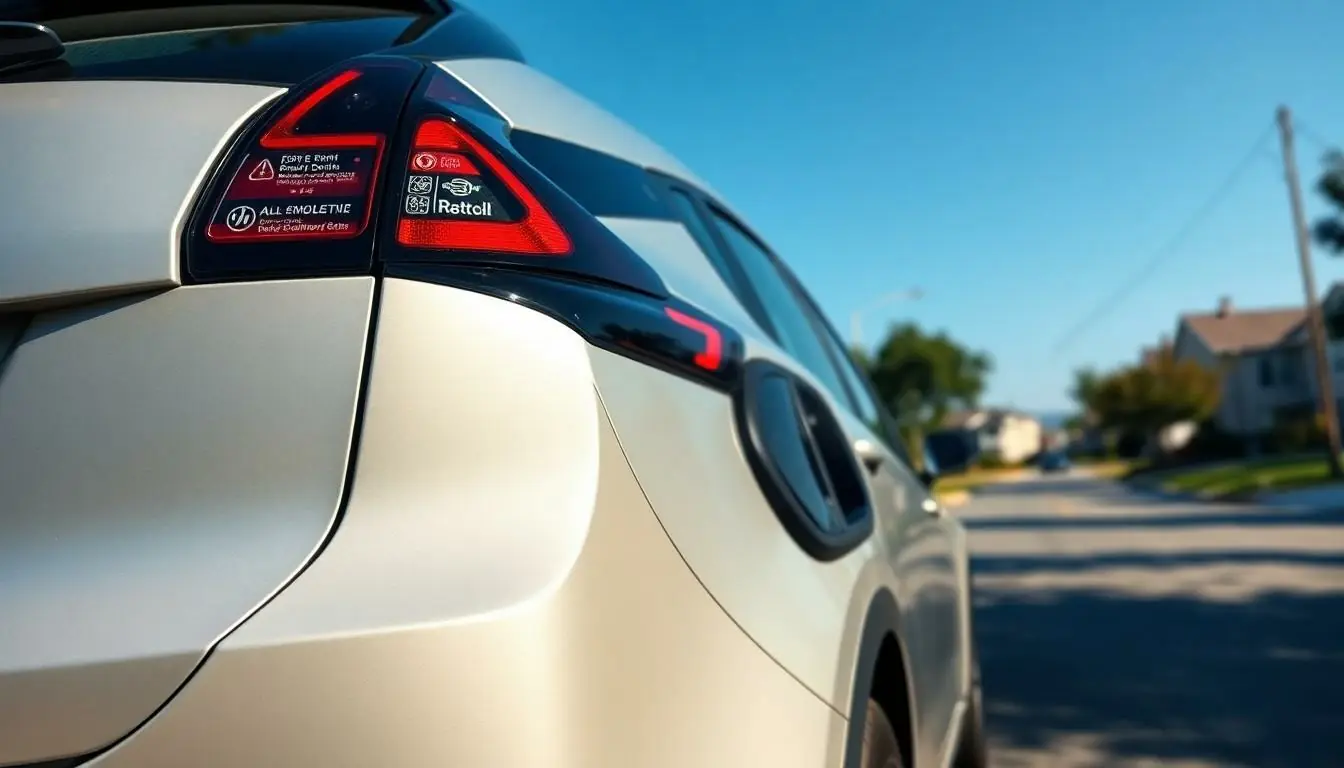Electric vehicles are taking the world by storm, and with that comes a whole new language of badges and labels. Think of them as the bling for your eco-friendly ride. These labels aren’t just for show; they serve a purpose. They tell the world your car runs on electrons instead of fossil fuels, and they help keep you compliant with regulations.
But here’s the kicker: every electric vehicle has its own set of rules about where those badges go. Yep, it’s like a scavenger hunt for car enthusiasts! Knowing the ins and outs of these placements can save drivers from potential fines and ensure they’re flaunting their eco credentials just right. So buckle up as we dive into the electrifying world of EV badges and labels—because who knew compliance could be this fun?
Table of Contents
ToggleOverview of Electric Vehicle Badges and Labels
Electric vehicle badges and labels indicate the eco-friendly nature of these vehicles. Specific regulations dictate where these badges must be placed, ensuring visibility. Manufacturers typically position badges on the rear of the vehicle and often on the sides. This placement helps inform other road users about the vehicle’s efficiency and environmentally friendly features.
Various badges exist for different purposes, including efficiency ratings and manufacturer branding. Compliance with regulatory standards ensures that drivers avoid fines while also promoting their commitment to sustainability. Additionally, certain vehicle classes may require distinct labels to indicate battery type or capacity.
Label formats differ based on geographical regulations. For instance, some regions might mandate specific colors or symbols to represent electric vehicles closely. This variety helps consumers quickly identify electric vehicles on the market. Moreover, recognizing these labels can enhance safety by reducing misunderstandings with other drivers or pedestrians.
Understanding the guidelines regarding badge and label placement is crucial for vehicle owners. Knowledge of these requirements supports compliance with local laws and regulations. Identifying the correct placement of badges also affects the vehicle’s resale value. Enhanced recognition leads to better acceptance of electric vehicles in general.
Throughout the industry, maintaining standardized badges and labels promotes brand identity among manufacturers. Familiarity with these visual indicators fosters trust in electric vehicles, benefiting both manufacturers and consumers.
Importance of Standardization

Standardization of badges and labels in electric vehicles plays a vital role in ensuring compliance with regulations. It establishes clear expectations for manufacturers regarding placement, promoting uniformity across the industry.
Regulatory Compliance
Regulatory compliance for electric vehicles hinges on the correct placement of badges and labels. Both federal and local guidelines dictate specific locations for these identifiers. Compliance avoids potential fines and legal issues. Standards vary by jurisdiction, meaning that each region may have its specific requirements for visibility and format. Manufacturers must stay updated with regulations to ensure adherence. Vehicle owners significantly benefit from understanding these compliant practices. They enhance vehicle safety by informing other road users of the vehicle’s eco-friendly status.
Consumer Awareness
Consumer awareness relies heavily on the visibility of badges and labels. Badges feature symbols and colors designed to quickly communicate the vehicle type to potential buyers. Such clarity fosters trust among consumers regarding the vehicle’s environmental impact. Awareness campaigns often highlight these features, making it easier for consumers to choose an electric vehicle that meets their preferences. Standards in labeling and badge design help consumers identify and differentiate electric vehicles from traditional cars. Enhanced recognition leads to more informed purchasing decisions, contributing to a growing market for electric vehicles.
Common Badges and Labels
Electric vehicles feature various standardized badges and labels that enhance eco-friendliness and compliance. Understanding these identifiers is crucial for drivers.
Eco Labels
Eco labels highlight the vehicle’s environmental benefits. These labels typically indicate energy efficiency ratings based on specific tests. Electric vehicles often display them prominently, usually on the rear and side panels. Bright colors or recognizable symbols make these labels easily identifiable. Standards for these eco labels may vary by region, with organizations like the Environmental Protection Agency setting guidelines in the U.S. Compliance with these specifications can affect a vehicle’s marketability. Buyers benefit from recognizing these labels, as they signify lower emissions and a commitment to sustainability.
Safety and Performance Badges
Safety badges emphasize compliance with federal safety standards. These badges provide assurance about the vehicle’s safety features, such as crash test ratings. Performance badges indicate battery range and charging capabilities, giving potential buyers valuable information. Each manufacturer has specific designs and placement rules for these badges. Visibility matters, as these identifiers help consumers make informed decisions. The positioning of safety and performance badges aids in compliance, reducing exposure to regulatory fines. Recognizing these badges fosters consumer confidence and promotes informed purchasing decisions.
Placement Guidelines
Correct placement of badges and labels on electric vehicles ensures compliance with regulations. Understanding specific requirements helps electric vehicle owners avoid fines.
Front and Rear Requirements
Badges on the front and rear of electric vehicles must adhere to specified guidelines. Manufacturers typically place eco labels prominently on the rear, offering visibility to other road users. Front placements often include the manufacturer’s logo or branding, identifying the vehicle’s zero-emission status. Specifically, the U.S. mandates that these identifiers maintain clear visibility and contrast against the vehicle’s color. Compliance with these regulations enhances consumer recognition and trust.
Side and Interior Badges
Side badges serve to reinforce the vehicle’s eco-friendliness while conveying efficiency ratings. Electric vehicles commonly display labels on the front fender or doors to ensure easy identification. Additionally, interior labels provide essential information, including battery range and charging capabilities. Consistent compliance with local regulations determines the appropriate placement of these badges. By positioning interior information in a visible area, manufacturers enhance user understanding and promote informed decisions regarding electric vehicle features.
Consequences of Non-Compliance
Non-compliance with badge and label regulations can lead to significant penalties for electric vehicle owners. Fines often vary by jurisdiction, with amounts ranging from $100 to $5,000 depending on the severity of the violation. Legal repercussions also pose a risk, as failure to adhere to guidelines might result in mandatory inspections or additional fees.
Compliance ensures vehicles meet federal and local standards. Compliance helps maintain the integrity of the EV market by encouraging honest representation of eco-friendliness. Inaccurate or missing labels can mislead consumers regarding environmental impact, leading to diminished trust and credibility in the electric vehicle sector.
Visibility plays a critical role in how badges are perceived. Badges placed incorrectly may not achieve their intended purpose of informing potential buyers about the vehicle’s eco-friendly status. This factor may discourage buyers from considering the vehicle, ultimately affecting resale value.
Safety implications exist as well, especially if consumers rely on these labels for important information. Reliability of battery range and charging specifications is crucial for informed purchasing. A lack of standardized badges could create confusion, resulting in buyers misunderstanding the vehicle’s capabilities.
Awareness campaigns often aim to highlight the importance of proper labeling. These initiatives reinforce the benefits of understanding and complying with label placement regulations. Educated consumers avoid the pitfalls of non-compliance while contributing to a more robust electric vehicle market.
Long-term consequences can extend beyond immediate fines or legal issues. Manufacturers may face repercussions for not adhering to placement guidelines, impacting their reputations. Ultimately, prioritizing compliance enhances consumer trust and strengthens the electric vehicle community.
Understanding the importance of standardized badges and labels on electric vehicles is essential for both compliance and consumer trust. Proper placement not only adheres to regulations but also enhances visibility for potential buyers. By showcasing their commitment to sustainability through these identifiers, vehicle owners can avoid penalties and promote informed purchasing decisions.
As the electric vehicle market continues to grow, recognizing the significance of these badges will play a critical role in shaping consumer perceptions and fostering a reliable EV community. Awareness and compliance will ultimately contribute to a stronger, more sustainable future for electric mobility.





